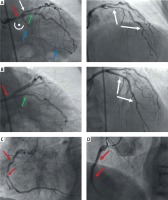Coronary artery disease (CAD) revascularization either by percutaneous coronary intervention (PCI) or coronary artery bypass grafting (CABG) improves the prognosis in patients with chronic coronary syndrome [1]. Whereas PCI is the gold standard for single-vessel disease, the choice of treatment for multivessel disease (MVD) is more challenging.
A 71-year-old male patient with MVD was admitted to the cardiology department with unstable angina. Electrocardiography showed atrial fibrillation with ventricular rate 70/min, no conduction disturbances and negative T waves in I, aVL and V4–V6 leads. Echocardiography demonstrated an enlarged left atrium (area 42 cm2), left ventricle hypertrophy (interventricular septum thickness 1.5 cm, posterior wall thickness 1.4 cm), no wall motion abnormalities with the left ventricle ejection fraction 60%, and mild regurgitation of the mitral, tricuspid and aortic valves. Coronary angiography showed 70% stenosis of the left main coronary artery (LMCA), diffuse significant lesions in the left anterior descending artery (LAD), 60–70% stenosis of the intermediate branch (IM), chronic total occlusion (CTO) of the circumflex artery in the middle segment with collateral circulation from the LAD and right coronary artery (RCA) to the distal segment, and diffuse lesions in the RCA with a fractional flow reserve of 0.63 (Figures 1 A, C). Considering the high anatomical complexity of the lesions (SYNTAX score 34), the Heart Team opted for surgical revascularization, which the patient refused. Regarding persistent ischemic symptoms, an attempt of percutaneous treatment was made.
Figure 1
A – Coronary angiography showing 70% stenosis of the left main coronary artery (red arrow), diffuse significant lesions in the left anterior descending artery (white arrows), 60–70% stenosis of the intermediate branch (green arrow) and chronic total occlusion of the circumflex artery in the middle segment (blue arrow), with collateral circulation from the left anterior descending artery and right coronary artery to the distal segment (blue arrow). B – Result of percutaneous coronary intervention with stent implantation to the left main coronary artery (3.5 × 23 mm, red arrow), two overlapping stents to the left anterior descending artery (3.0 × 33 mm, 2.5 × 33 mm; white arrows) and a stent to the intermediate branch (2.75 × 12 mm; green arrow). It was not feasible to insert the guidewire into the circumflex artery due to the origin angle (~90°, curved white line). C – Coronary angiography showing diffuse lesions in the right coronary artery (red arrows) with a fractional flow reserve of 0.63. D – Result of percutaneous coronary intervention with implantation of two overlapping stents to the right

During the first PCI, femoral access was chosen due to the high lesion complexity. Initial wire manipulations led to thrombus formation in the LMCA, with TIMI 1 flow in the LAD. The patient required immediate dobutamine support and abciximab administration. Emergency PCI of the LMCA towards LAD was performed with everolimus-eluting stent implantation (EES; 3.5 × 23 mm). Subsequently, two overlapping EES (3.0 × 33 mm; 2.5 × 33 mm) were implanted in the proximal and middle segments of the LAD (Figure 1 B). An attempt was made to insert the guidewire into the proximal segment of the chronically obstructed circumflex artery. This was not feasible due to the origin angle close to 90°, requiring the use of a 90° microcatheter, which was not available.
The patient remained hypotonic and required dobutamine support (5–10 μg/kg/min) for 24 h after the procedure. Despite pre-hydration, he experienced transient acute kidney injury. In addition, pseudoaneurysm of the right femoral artery was diagnosed and treated with endovascular embolization.
The second stage of PCI was postponed until the clinical stabilization. Two EES (3.5 × 38 mm; 4.0 × 38 mm) were implanted into the RCA via the right radial artery access (Figure 1 D). The anginal symptoms alleviated and the further course was uneventful, confirming the completeness of revascularization by clinical judgement [2]. Control echocardiography showed no new wall motion abnormalities and normal left ventricle ejection fraction. The two-year-follow-up after the procedures was uneventful.
In conclusion, there is a clear indication for CABG in patients with three-vessel MVD and a high SYNTAX score [1]. In case of the patient’s refusal, PCI is a feasible alternative to achieve close-to-complete revascularization, yet challenging and associated with potential complications. First, wire manipulations in the LMCA may lead to thrombus formation and hemodynamic instability. Second, staged PCI in MVD often requires multiple access routes, increasing the risk of access site complications [3]. Third, multiple procedures with contrast administration are associated with contrast-induced acute kidney injury, which increases the risk of mortality [4]. Finally, the radiation burden due to repeated complex PCIs should not be neglected. Careful planning, operator’s experience and complication risk should all be taken into account when making the final decision regarding the treatment choice.


